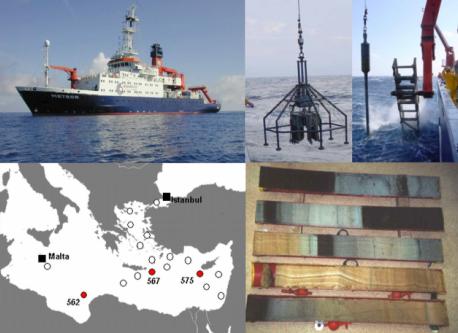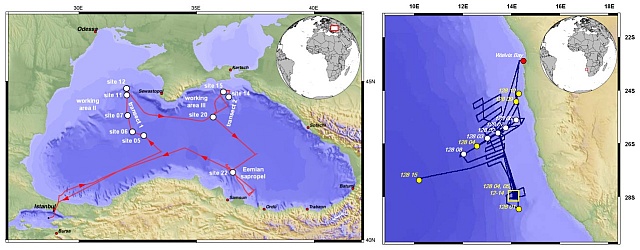Contact
Dr. Bert Engelen

Institute for Chemistry and Biology of the Marine Environment (» Postal address)
Prof. Dr. Heribert Cypionka
Meteor projects (2002-2005)
Cultivation and molecular characterization of bacteria from sapropel layers of the Eastern Mediterranean
Eastern Mediterranean sapropels are organic-rich sediment layers formed every 21.000 years due to climate fluctuations that result in deep-water anoxia. Sapropels were shown to harbor a higher number of active microorganisms in comparison to adjacent sediment layers.
(Coolen et al. 2002)
After "Meteor cruise M51-3" (Overmann et al. 2003), a unique culture collection from sapropel-bearing sediments was established applying optimised cultivation techniques (Süß et al, 2004). A molecular-guided cultivation lead to an increasing cultivation efficiency (Süß et al. 2007b).
The culture collection comprises typical marine bacteria but also microrganisms that were supposed to have a terrestrial origin (e.g. Rhizobium radiobacter). Due to our quantitative molecular investigations we have determined that R. radiobacter counts for up to 5% of all bacteria in sapropels. This was the first study to demonstrate the in-situ abundance of a cultivated deep-biosphere bacterium (Süß et al. 2006).
The phylogenetic variety of the detected isolates suggests a high microbial diversity within Mediterranean sapropels. Furthermore, we have shown that distinctive subpopulations of single species were formed and established there (Süß et al. 2007a). Therefore, we conclude that Eastern Mediterranean sapropels are populated by dynamical and highly diverse microbial communities.
Team
- Jacqueline Süß
- Katja Ziegelmüller
- Kerstin Herrmann
- Henrik Sass
- Bert Engelen
- Heribert Cypionka
Related publications
- Süß, Jacqueline (2006) Dissertation: "Kultivierungsabhängige Analyse mikrobieller Gemeinschaften in Sapropelen des östlichen Mittelmeeres"
- Süß J, Herrmann K, Seidel M, Cypionka H, Engelen B, and Sass H (2008) Two distinct Photobacterium populations thrive in ancient Mediterranean sapropels. Microb Ecol 55:371-383
- Süß J, Schubert K, Sass H, Cypionka H, Overmann J, Engelen B (2006) Widespread distribution and high abundance of Rhizobium radiobacter within Mediterranean subsurface sediments. Environm Microbiol 8:1753-1763
- Süß J, Engelen B, Cypionka H, Sass H (2004) Quantitative analysis of bacterial communities from Mediterranean sapropels based on cultivation-dependent methods. FEMS Microbiol Ecol 51:109-121
- Overmann J, Schubert K, Hoffelner H, Engelen B (2003) Characterization of Bacteria in Sapropels, in Overlaying Sediments and Water Layers by a Multidisciplinary Approach. In: Hemleben C, Hoernle K, Jørgensen BB, and Roether W (Eds.), 2001, Ostatlantik - Mittelmeer - Schwarzes Meer, Cruise No. 51, 12 September - 28 December 2001. METEOR-Berichte, Universität Hamburg, 03-1, 225 pp. 3-32 - 3-40, ISSN 0936-8957
- Coolen MJL, Cypionka H, Sass A, Sass H, Overmann J (2002) Ongoing modification of Mediterranean Pleistocene sapropels by green nonsulfur bacteria and crenarchaeota. Science 296:2407-2410
Links
- Detailed cruise report
Origin of deep-biosphere bacteria in sediments of the Black Sea and the Namibian Upwelling Area
The marine deep biosphere represents the largest biotope on Earth. Throughout the last years, we have obtained interesting insights into its community composition. As some of the microbial groups detected in deep marine sediments have close relatives in other environments, the question arises how the populations enter their habitat.
The scientific goal of this project is to understand the origin of deep-subsurface bacteria. We would like to clarify whether bacteria that are settling down from the water column survive after being buried in the sediment or whether the deep biosphere is composed of specific types that have evolved or thrive in the sediment, only. To reach these goals, samples from the Black Sea collected during Meteor cruise M72/5 and samples taken from the coast off Namibia during Meteor cruise M76/1 will be analyzed by microbiological and molecular methods.
Instead of performing a complete community analysis, we are focusing on four bacterial representatives as model organisms to study their distribution and trace their way from open waters into deeper sediment layers. Three of the bacterial groups to be studied (Rhizobium, Photobacterium, Roseobacter clade) are facultative aerobes and have cultured representatives in marine sediments and in the water column, while one (Chloroflexi) represents the most abundant bacterium in the deep biosphere, but has not yet been cultured from this habitat.
A specific quantification by CARD-FISH and qPCR will be performed along regional transects from shallow to deep sediments. Molecular screening of serial dilution cultures will be used to identify and isolate microorganisms with a unique phylotype. New isolates will be characterized with respect to their specific physiological adaptations (e.g. to pressure). Special attention will be given to an Eemian (about 120.000 years old) Black Sea sapropel which allows a comparison with previously studied Mediterranean sapropels of similar age.
Team
- Monika Sahlberg
- Judith Lucas
- Odeta Shuti
- Nontje Straaten
- Heidi Wiechmann
- Bert Engelen
- Heribert Cypionka
Related publications
- Kraft B, Engelen B, Goldhammer T, Lin Y-S, Cypionka H, Könneke M (2012) Desulfofrigus spec. prevails in sulfate-reducing dilution cultures from sediments of the Benguela upwelling area. FEMS Microbiol Ecol 84:86-97
- Sass H, Köpke B, Rütters H, Feuerlein T, Dröge S, Cypionka H, Engelen B (2010) Tateyamaria pelophila sp. nov. a facultatively anaerobic Alphaproteobacterium isolated from tidal-flat sediments, and emended descriptions of the genus Tateyamaria and of Tateyamaria omphalii. IJSEM 60:1770-1777
- Süß J, Herrmann K, Seidel M, Cypionka H, Engelen B, and Sass H (2008) Two distinct Photobacterium populations thrive in ancient Mediterranean sapropels. Microb Ecol 55:371-383
- Süß J, Schubert K, Sass H, Cypionka H, Overmann J, Engelen B (2006) Widespread distribution and high abundance of Rhizobium radiobacter within Mediterranean subsurface sediments. Environm Microbiol 8:1753-1763
- Süß J, Engelen B, Cypionka H, Sass H (2004) Quantitative analysis of bacterial communities from Mediterranean sapropels based on cultivation-dependent methods. FEMS Microbiol Ecol 51:109-121
- Wilms R, Köpke B, Sass H, Chang TS, Cypionka H, Engelen B (2006) Deep biosphere-related bacteria within the subsurface of tidal flat sediments. Environ Microbiol 8:709-719
- Coolen MJL, Cypionka H, Sass A, Sass H, Overmann J (2002) Ongoing modification of Mediterranean Pleistocene sapropels by green nonsulfur bacteria and crenarchaeota. Science 296:2407-2410



![[Translate to English:]](/f/5/_processed_/3/2/csm_ICBM-Logo-transparent-_91fe1c6774.png)

